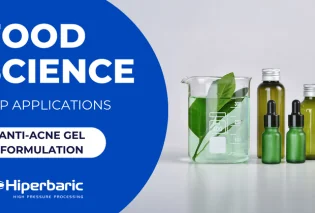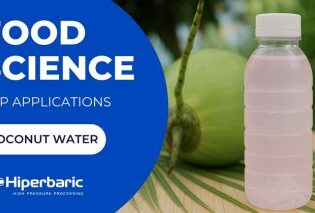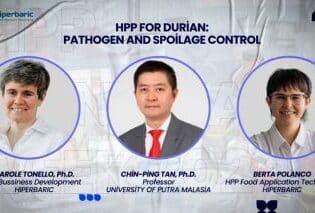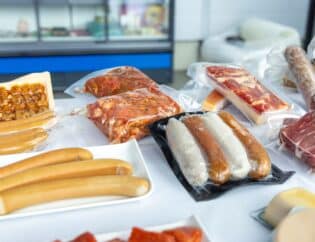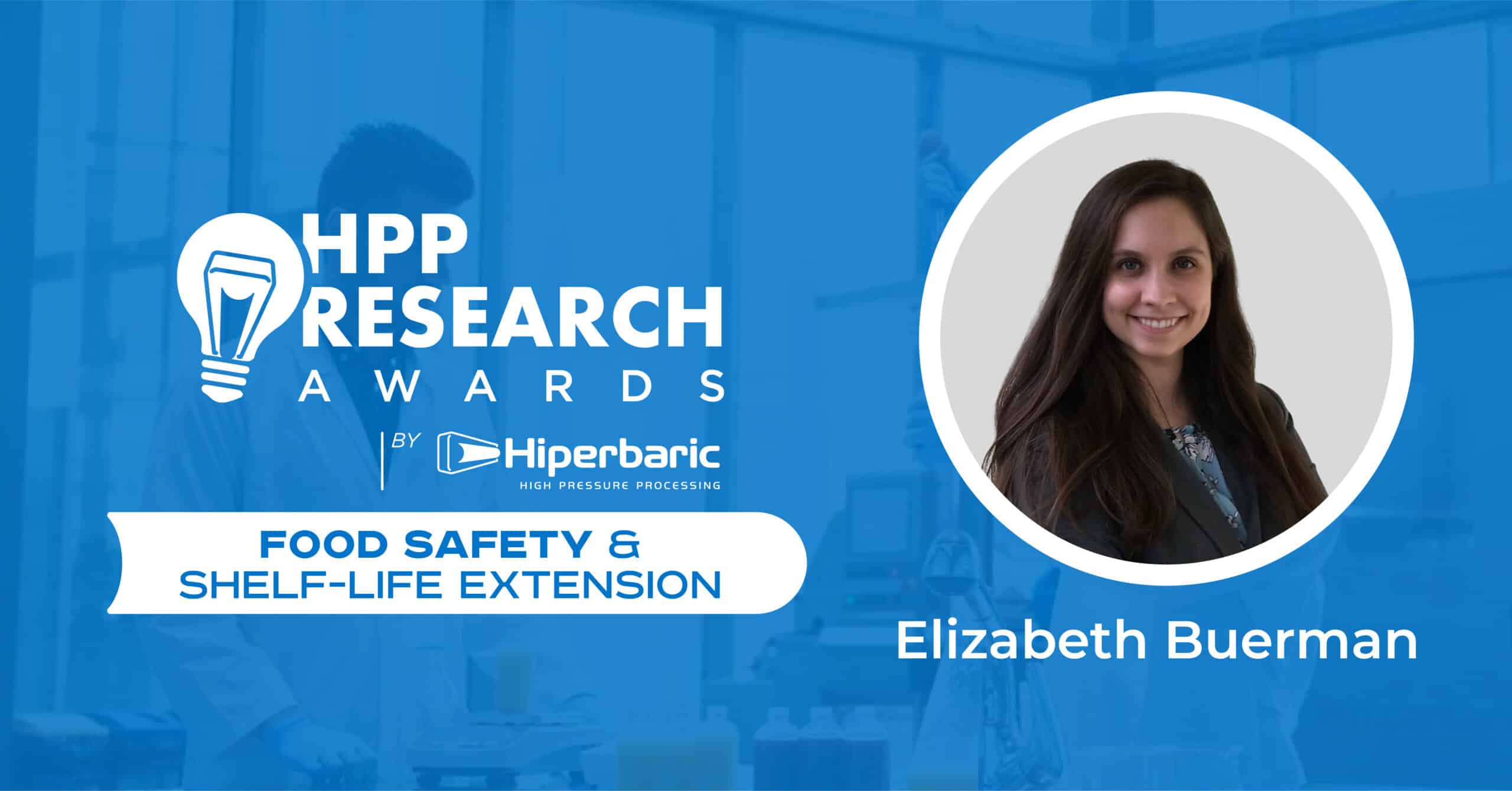

The goal of this study was to evaluate the pressure and time necessary to cause a reduction of spoilage fungi common in juice and determine the effect of water activity (0.94–1.0 aw) and pH (3.5–7.0) on HPP inactivation kinetics. The effect of sulfites and dimethyl dicarbonate was also assessed as a proof of concept to determine if either aided in fungal inactivation. Refrigerated storage up to 26 weeks after treatment was performed. Generally, a greater reduction of all fungi tested was observed at 1.0 aw than at 0.94 aw while the pH effect varied. A 17–26 week refrigerated storage period after processing at 5°C, 600 MPa for 15 min, could be achieved.
High pressure processing (HPP) is a popular method of processing juices to retain “fresh” properties. However, heat and pressure resistant fungi, Byssochlamys spp. and Aspergillus spp., can survive processing and cause spoilage. In fact, HPP can act as an activation step resulting in germination and potential unwanted swelling, visible growth during shelf life. Highly resistant organisms relevant to the juice industry include Aspergillus pseudoglaucus (Eurotium repens), Aspergillus fischeri (Neosartorya fischeri), and Paecilomyces niveus (Byssochlamys nivea Westling). Hurdle technology or combining methods synergistically may help to reduce these spoilage organisms and extend shelf life with potential to: increase pressure, increase processing times, adjust pH, adjust water activity and/or add processing aids. The goal of this study was to evaluate the pressure and time necessary to cause a reduction of heat and pressure resistant spoilage fungi common in juice and determine the effect of water activity (0.94–1.0 aw) and pH (3.5–7.0) on HPP inactivation kinetics. The effect of sulfites (8 ppm) and dimethyl dicarbonate (DMDC; 250 ppm) was also assessed as a proof of concept to determine if either aided in fungal inactivation. Storage up to 26 weeks after treatment was performed to assess fungal growth.
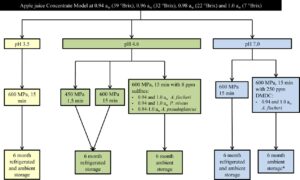
*pH 7.0 ambient storage to evaluate fungi survival.
Processing A. pseudoglaucus in pH 3.5 diluted apple juice concentrate (DAJC) at 600 MPa for 15 min at 5°C was more effective than in pH 4.6, 7.0, or 4.6 with sulfites. Growth occurred quickly when stored ambient. Refrigerated conditions were not sufficient to meet the full 26 weeks shelf life – A. pseudoglaucus in refrigerated pH 3.5 solutions showed recovery and growth at 0.94 and 0.96 aw at week 17. Visible A. pseudoglaucus growth occurred at week 6 in pH 4.6 samples processed at 450 MPa for 1.5 min, 0.94–1.0 aw and stored at refrigeration, while visible growth was delayed until week 20 in samples processed at 600 MPa for 15 min, 0.94–0.98 aw and stored at refrigeration. A. pseudoglaucus samples at 1.0 aw, pH 4.6, and processed at 600 MPa for 15 min did not grow for 26 weeks at refrigeration. Adding sulfites was significantly better at reducing A. pseudoglaucus in 4.6 pH DAJC when compared to the 4.6 pH condition without sulfite. However, even A. pseudoglaucus samples with sulfite exhibited visible mycelia within a few weeks at ambient storage. Processing A. pseudoglaucus in pH 3.5 at 0.94–1.0 aw and in pH 7.0 at 0.94 and 1.0 aw DAJC was more effective at reducing populations than adding 8 ppm sulfite to pH 4.6 DAJC.
pH differences were less distinct with A. fischeri. Processing A. fischeri at pH 3.5 or 7.0 for 15 min at 600 MPa, 5°C or at pH 4.6 for 1.5 min at 450 MPa resulted in a 1-log reduction. Instead of improving the reductions, both the addition of 8 ppm sulfite and 250 ppm DMDC caused a greater activation of spores at the conditions studied. All ambient storage conditions tested showed growth within a few weeks, but all refrigerated shelf life conditions maintained a constant level of A. fischeri, up to 26 weeks without visible mycelia.
P. niveus was the most pressure resistant species tested. Nearly every condition caused spore germination, with the only reduction of P. niveus occurring at 0.94 aw, 4.6 pH, 450 MPa for 1.5 min. P. niveus was capable of growth during ambient storage, but not during refrigerated storage, even when activation of ascospores was triggered by high pressure. The addition of sulfites to the 0.94 awsamples of P. niveus may have extended the ambient storage by several weeks. However, the addition of sulfites to the 1.0 aw samples did not aid in storage extension.
Overall, the genera of filamentous fungi tested proved to be very pressure resistant. Generally, a greater reduction of all fungi tested was observed at 1.0 aw than at 0.94 aw. A. pseudoglaucus was the most pressure sensitive of the three species tested, while P. niveus proved to be the most resistant. However, the two most resistant species, P. niveus and A. fischeri, were incapable of growth at refrigerated conditions for up to 26 weeks. A. pseudoglaucus was capable of growth during refrigerated storage, but was more susceptible to high pressure and therefore may be of most interest to manufacturers looking for target processing parameters. The addition of 8 ppm potassium metabisulfite at pH 4.6 had varying effects between species and did not significantly increase the ambient shelf life. A 17–26 week storage period could be achieved, but only at refrigeration.



